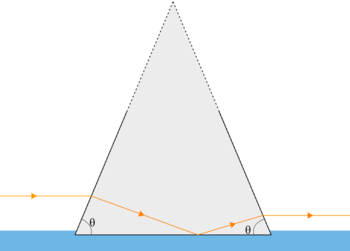Coming Out The Same Way

A glass prism whose cross-section is an isosceles triangle stands with its (horizontal) base in water; the angles that its two equal sides make with the base are each .
An incident ray of light, above and parallel to the water surface and perpendicular to the prism's axis, enters the prism and is internally reflected at the glass-water interface and re-emerges into the air. Taking the refractive indices of glass and water to be and , respectively.
Calculate the minimum value of (in radians) for total internal reflection to be possible.
Give your answer to 3 decimal places.
The answer is 0.45163.
This section requires Javascript.
You are seeing this because something didn't load right. We suggest you, (a) try
refreshing the page, (b) enabling javascript if it is disabled on your browser and,
finally, (c)
loading the
non-javascript version of this page
. We're sorry about the hassle.
Observe that the angle of incidence of the incident ray is 2 π − θ radians as the ray is parallel to the base.
Now using Snell's Law for the refraction, sin r 1 sin ( π / 2 − θ ) = μ ⟹ sin r 1 cos ( θ ) = 2 3 . ⋅ ⋅ ⋅ ⋅ ⋅ ⋅ E q n ( 1 )
Next, for Total Internal Reflection to take place, sin ( r 1 + θ ) > μ 1 μ 2 ⟹ sin ( r 1 + θ ) > 2 3 3 4 = 9 8 .
⟹ r 1 + θ > arcsin ( 8 / 9 ) ≈ 6 2 . 7 3 4 degrees ⋅ ⋅ ⋅ ⋅ ⋅ ⋅ E q n ( 2 )
Finally using ( 1 ) and ( 2 ) , solve for the minimum value of θ ≈ 0 . 4 5 1 radians that satisfies this.